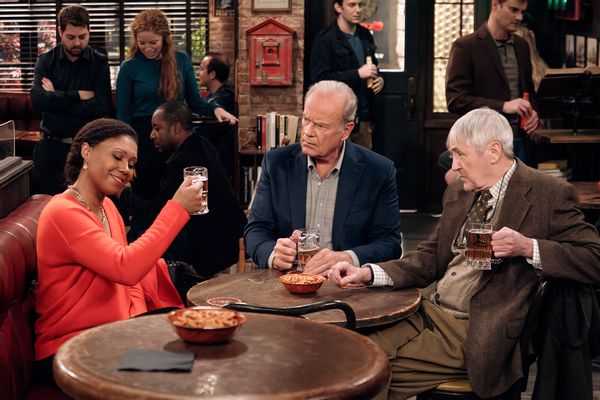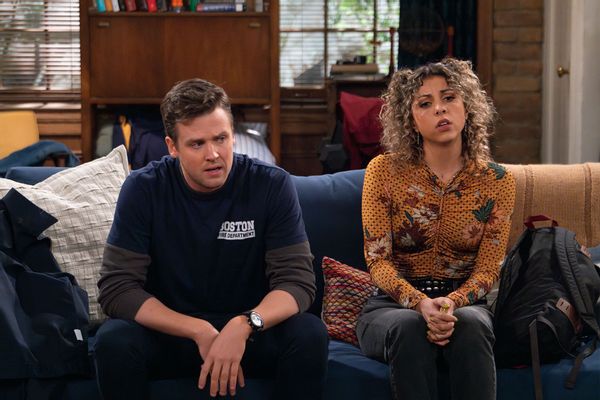
Television’s Memory Lane has as many versions as there are Atlanta streets named Peachtree, with only a few of those causeways seeing heavy traffic. Avenues memorializing “Frasier” may not be among them, despite Kelsey Grammer's “Cheers”-spinoff being a ratings force in its day, snagging five consecutive years’ worth of best comedy Emmys and running for 11 seasons.
It also ended well in 2004, satisfying longtime viewers by leaving its characters in good places, especially Dr. Frasier Crane, who had long been unlucky in love and finally found a love match in Laura Linney’s Charlotte.
Our last glimpse of Frasier shows him choosing Charlotte over a TV show in a bigger market than his longtime home Seattle and choosing Chicago over Seattle or San Francisco — a flawlessly symmetric bow on a story that began long ago in Boston. Where’s the value in unpacking that?
Networks are perpetually giddy to answer that question. If “Will & Grace” can crawl out of the grave and “That ‘70s Show” can return as “That ‘90s Show,” there's no reason to assume the good doctor is immune to the affliction we'll call revivalitis.
But there’s a difference between breathing new life into a three-decade-old title and whatever awkward necromancy unnaturally extending the life of “Frasier” achieves without adding fresh layers to its eponymous figure. Remember how terrific “Murphy Brown” was for 10 seasons before it ended in 1998? What did you think of season 11, which ran in 2019? (Yes, there was season 11.)
This revivalitis outbreak may not be so forgettable, but it does rely on our affection for resuming familiar patterns. We rejoin our attentive therapist on his way to Paris, which he precedes with a stop in Boston to visit his son, Freddy (Jack Cutmore-Scott), last seen dutifully following the nerd map written into his DNA. Since then, Freddy ditched his parent-approved Harvard undergraduate track to become a firefighter — Mr. July on his department’s calendar, in fact — thereby disappointing his father.
Before we get into that dynamic, you may be wondering why the show is airing on Paramount+ instead of NBC or Peacock. While the original series premiered on NBC, “Frasier” was produced by Paramount, which now has a streaming service to feed. Thus, Grammer’s return to the field of psychiatry in some respect was probably inevitable. As for the ensemble’s other regulars, David Hyde Pierce opted to leave Niles Crane packed in amber. John Mahoney, who played Frasier’s father Martin, died in 2018.
Peri Gilpin is set to return as Frasier’s no-nonsense Seattle producer Roz, but by the time it happens, we may wonder what purpose it serves beyond reminding us that this new show has threads of connection to the old. (Bebe Neuwirth, who plays Freddy’s mother and Frasier’s ex Lilith, is also scheduled to drop by.) But we’re already getting these through the characters showrunners Joe Cristalli and Chris Harris have arranged around Frasier, which are basically new versions of the old gang.
Since Freddy and Frasier are estranged, and with Harvard in need of his magnificent insight and wit, Frasier decides to return to Beantown, triumphant. In the 19 years since we last saw him, Frasier became the host of a successful TV talk show, making him as recognizable Dr. Phil, minus the abusive trauma theater.

The new “Frasier” moves to the same structural rhythms as the old “Frasier,” which would be a comfort if we didn’t already have more than a decade’s worth of the character’s adventures to revisit whether via Paramount+ or Hallmark, where it lingers on by way of a syndicated afterlife.
But what's the value of recreating the same dynamics in the namesake character’s life without establishing new challenges for him? The revival forces us to ask that question, especially in the creaky two episodes currently streaming, directed by the legendary James Burrows. Before you watch those, you may want to revisit the two-part 2004 finale.
Provided you remember “Frasier,” you might not need to. Crashing the Crane brothers’ highbrow sensibilities against their humble origins is the show’s comedic fuel, of which we’re constantly reminded in the first go-round by Martin, a retired cop, and Martin’s caretaker, Daphne Moon (Jane Leeves).
It's also the source of Frasier’s winning vulnerability, distilled by Grammer into a cocktail of haughty sangfroid, grumpiness and keen loneliness.
Frasier injected a similar energy into “Cheers” once he joined that cast in its third season. But when “Frasier” creators David Angell, Peter Casey and David Lee spun him off from said classic, they didn’t recycle the used clay that was Sam, Norm, Cliff, Woody and so on into Seattle counterparts.
Cristalli and Harris didn't follow that example. Niles’ son, David (Anders Keith), is essentially a combination of Niles and Martin’s wire-haired Jack Russell terrier Eddie instead of Niles and Daphne. He's all elbows, left feet and tail-wagging eagerness. Niles' sensible half shows up in Lyndhurst’s Alan, Frasier’s confidante providing the adult insight David lacks.

Every Seattle resident will tell you the dreamy view from Frasier’s condo in those classic episodes is as non-existent as Café Nervosa. The producers’ efforts to tip their hat to the place resulted in some comedic mispronunciations of locales like Lake Chelan. It’s much easier to cultivate the show’s Ivy League bona fides by dropping lines such as, “Explain it to me like I’m a student at Tufts.”
It didn’t matter if the cast and writers didn’t quite nail Seattle as a character because the action revolved around Frasier and what he represented, especially as a figure straddling the end of the Clinton Era and the first four years of George W. Bush’s presidency.
Frasier was and is the embodiment of the wine-swilling coastal elite clowned and vilified by conservatives from Rush Limbaugh to every Fox News pundit one can name. He drove a BMW, not a Volvo (still, the stereotype fits). Grammer is a lifelong Republican, but regardless of one’s politics, everyone laughed with and at his fussy therapist, and the empathy he engendered was nearly ubiquitous. Both then and now, the scripts allow for stillness, letting the audience marinate in a character’s sensitive insights and confessions between the zingers.
Like Frasier’s profession, this strategy is portable. But the audience has changed enough for the past version of the show to seem of its time even as the character remains timeless. The “Frasier” revival acknowledges its therapists’ part in our modern obsession with fame and fortune in the third episode, where we receive a glimpse of where his show began — as a serious healing endeavor — versus the audience-pandering vaudeville act it became in its final seasons.
Frasier Crane is a man divided between his need for validation and his urge for refinement and solitude. Perhaps the most touching part of the 2004 finale arrives when Frasier closes the door on a man who has removed Martin’s beaten-up old lounger. He places his beloved Eames chair in its spot, sits down and quietly listens to the rainfall exactly where he’s always wanted to be.
A beat after we experience this satisfaction with him, Frasier makes a phone call we’re made to believe is launching his next chapter — in a new city, and with the fresh challenge of mounting a TV show. We can only imagine the possibilities that could have emerged from depicting the character’s steadfast standards butting against the crass, psychologically draining demands of a viewership-driven business. Instead, we’re invited to settle for a version of history repeating itself. Who knows how many people want to go down that road again?
The first two episode of "Frasier" are streaming on Paramount+.







